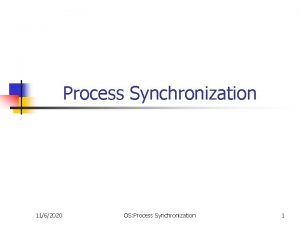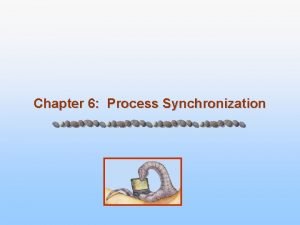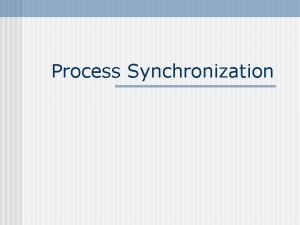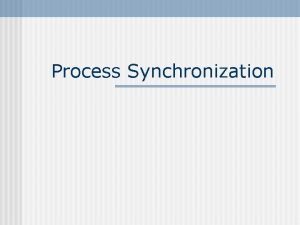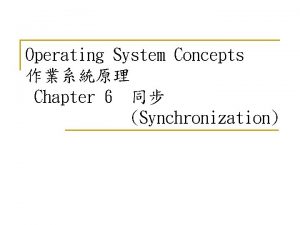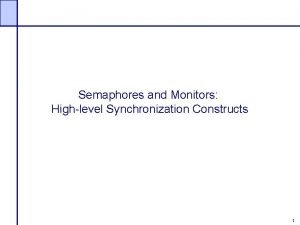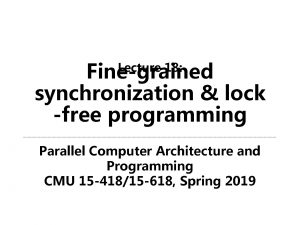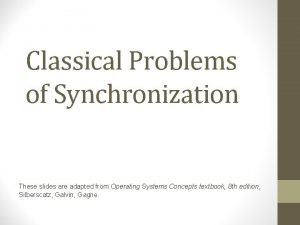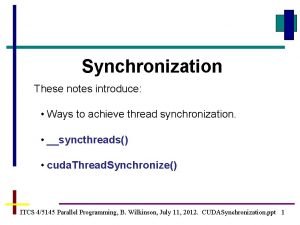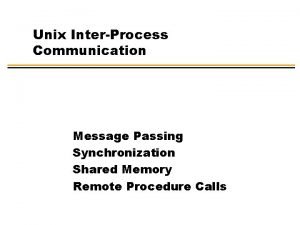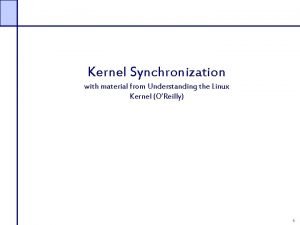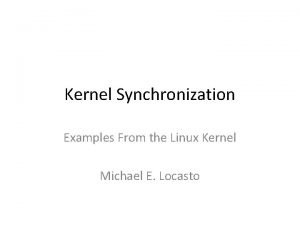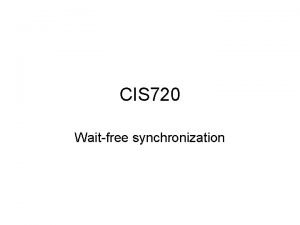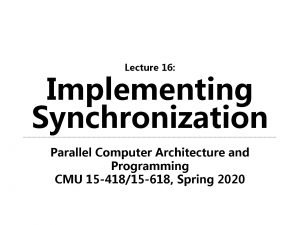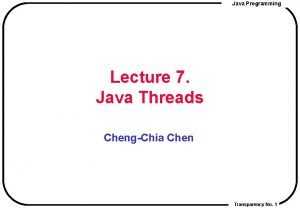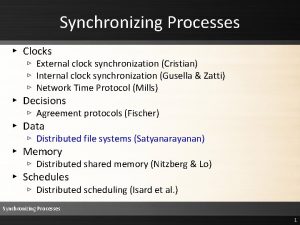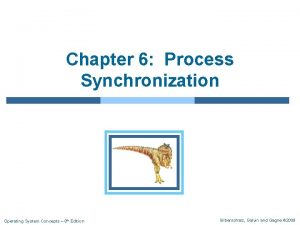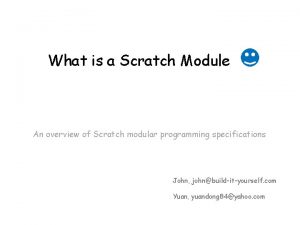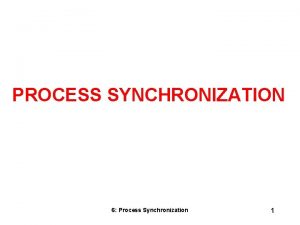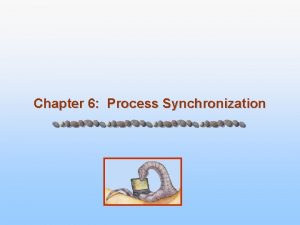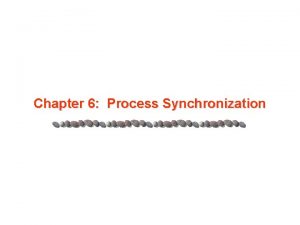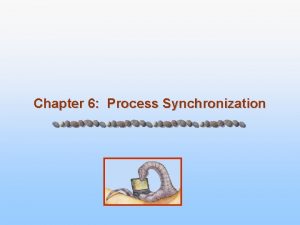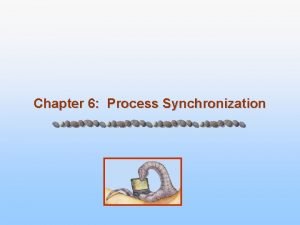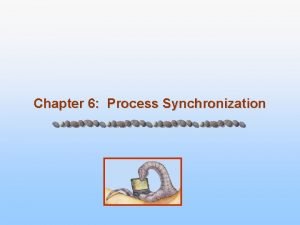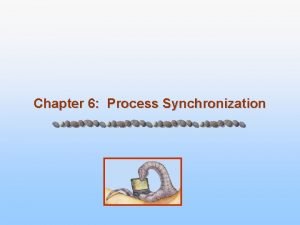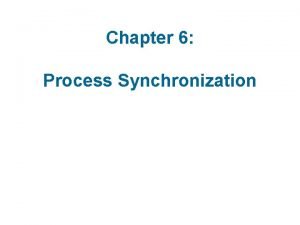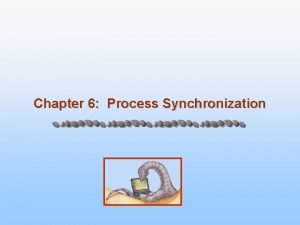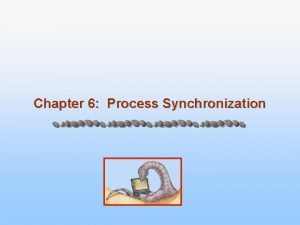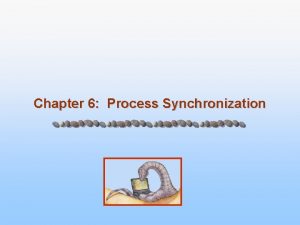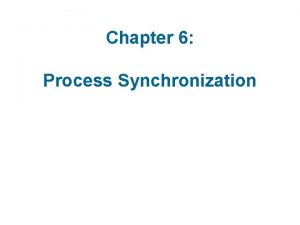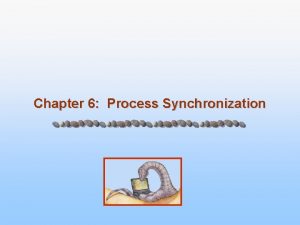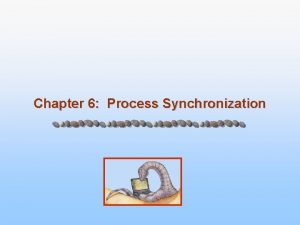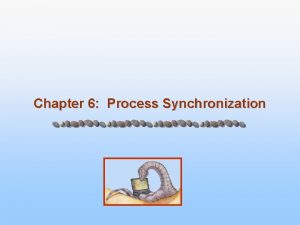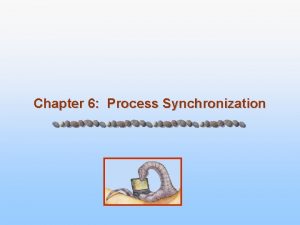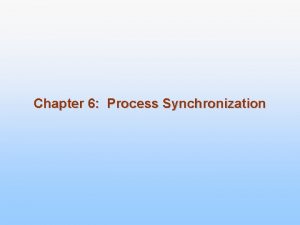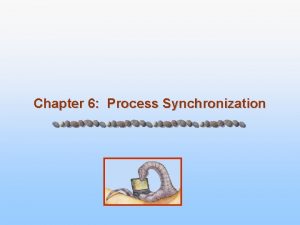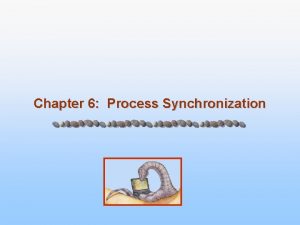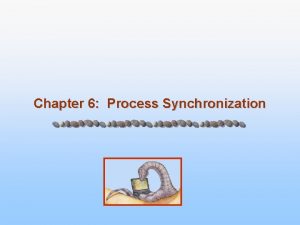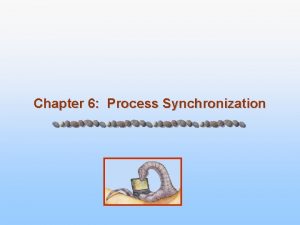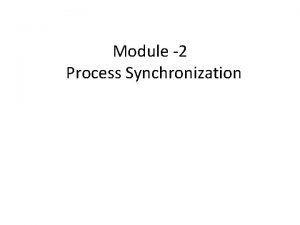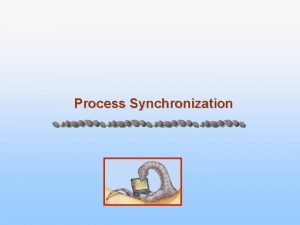Chapter 6 Process Synchronization Module 6 Process Synchronization















![Algorithm for Process Pi do { flag[i] = TRUE; turn = j; while ( Algorithm for Process Pi do { flag[i] = TRUE; turn = j; while (](https://slidetodoc.com/presentation_image_h/b168c0a2bd57f55cc6d32b03cf9688ab/image-16.jpg)
































![Solution to Dining Philosophers monitor DP { enum { THINKING; HUNGRY, EATING) state [5] Solution to Dining Philosophers monitor DP { enum { THINKING; HUNGRY, EATING) state [5]](https://slidetodoc.com/presentation_image_h/b168c0a2bd57f55cc6d32b03cf9688ab/image-49.jpg)










- Slides: 59

Chapter 6: Process Synchronization

Module 6: Process Synchronization n n n n Background The Critical-Section Problem Peterson’s Solution Synchronization Hardware Semaphores Classic Problems of Synchronization Monitors Synchronization Examples Atomic Transactions Operating System Concepts 6. 2 Silberschatz, Galvin and Gagne © 2005

Producer-Consumer Problem n Paradigm for cooperating processes, producer process produces information that is consumed by a consumer process l unbounded-buffer places no practical limit on the size of the buffer l bounded-buffer assumes that there is a fixed buffer size Operating System Concepts 6. 3 Silberschatz, Galvin and Gagne © 2005

Bounded-Buffer – Shared-Memory Solution n Shared data #define BUFFER_SIZE 10 Typedef struct {. . . } item; item buffer[BUFFER_SIZE]; int in = 0; int out = 0; Operating System Concepts 6. 4 Silberschatz, Galvin and Gagne © 2005

Bounded-Buffer – Insert() Method //Producer while (true) { /* Produce an item */ while (((in = (in + 1) % BUFFER SIZE count) == out) ; /* do nothing -- no free buffers */ buffer[in] = item; in = (in + 1) % BUFFER SIZE; } Operating System Concepts 6. 5 Silberschatz, Galvin and Gagne © 2005

Bounded Buffer – Remove() Method //Consumer while (true) { while (in == out) ; // do nothing -- nothing to consume // remove an item from the buffer item = buffer[out]; out = (out + 1) % BUFFER SIZE; return item; } Operating System Concepts 6. 6 Silberschatz, Galvin and Gagne © 2005

Bounded Buffer n Problem in previous example? Solution is correct, but can only use BUFFER_SIZE-1 elements, by assuming one producer and one consumer Operating System Concepts 6. 7 Silberschatz, Galvin and Gagne © 2005

Background n Concurrent access to shared data may result in data inconsistency n Maintaining data consistency requires mechanisms to ensure the orderly execution of cooperating processes n Suppose that we wanted to provide a solution to the consumer-producer problem that fills all the buffers. We can do so by having an integer count that keeps track of the number of full buffers. Initially, count is set to 0. It is incremented by the producer after it produces a new buffer and is decremented by the consumer after it consumes a buffer. Operating System Concepts 6. 8 Silberschatz, Galvin and Gagne © 2005

Producer while (true) /* produce an item and put in next. Produced while (count == BUFFER_SIZE); // do nothing buffer [in] = next. Produced; in = (in + 1) % BUFFER_SIZE; count++; } Operating System Concepts 6. 9 Silberschatz, Galvin and Gagne © 2005

Consumer while (1) { while (count == 0); // do nothing next. Consumed = buffer[out]; out = (out + 1) % BUFFER_SIZE; count--; /* consume the item in next. Consumed } Operating System Concepts 6. 10 Silberschatz, Galvin and Gagne © 2005

Question? n What problem do we have in the solution using count? Operating System Concepts 6. 11 Silberschatz, Galvin and Gagne © 2005

Race Condition n count++ could be implemented as register 1 = count register 1 = register 1 + 1 count = register 1 n count-- could be implemented as register 2 = count register 2 = register 2 - 1 count = register 2 n Consider this execution interleaving with “count = 5” initially: S 0: producer execute register 1 = count {register 1 = 5} S 1: producer execute register 1 = register 1 + 1 {register 1 = 6} S 2: consumer execute register 2 = count {register 2 = 5} S 3: consumer execute register 2 = register 2 - 1 {register 2 = 4} S 4: producer execute count = register 1 {count = 6 } S 5: consumer execute count = register 2 {count = 4} Operating System Concepts 6. 12 Silberschatz, Galvin and Gagne © 2005

Solution to Critical-Section Problem MUST satisfy the following three requirements: 1. Mutual Exclusion - If process Pi is executing in its critical section, then no other processes can be executing in their critical sections 2. Progress - If no process is executing in its critical section and there exist some processes that wish to enter their critical section, then the selection of the processes that will enter the critical section next cannot be postponed indefinitely 3. Bounded Waiting - A bound must exist on the number of times that other processes are allowed to enter their critical sections after a process has made a request to enter its critical section and before that request is granted Assume that each process executes at a nonzero speed No assumption concerning relative speed of the N processes Operating System Concepts 6. 13 Silberschatz, Galvin and Gagne © 2005

Solution to Critical-Section Problem do { Entry Section CRITICAL SECTION Exit Section REMAINDER SECTION } while (TRUE); Operating System Concepts 6. 14 Silberschatz, Galvin and Gagne © 2005

Peterson’s Solution n A classic software-based solution to the critical-section n n problem Two process solution Assume that the LOAD and STORE instructions are atomic; that is, cannot be interrupted. The two processes share two variables: l int turn; l Boolean flag[2] The variable turn indicates whose turn it is to enter the critical section. If turn == i, then process Pi is allowed to execute in its critical section n The flag array is used to indicate if a process is ready to enter the critical section. flag[i] = true implies that process Pi is ready! Operating System Concepts 6. 15 Silberschatz, Galvin and Gagne © 2005
![Algorithm for Process Pi do flagi TRUE turn j while Algorithm for Process Pi do { flag[i] = TRUE; turn = j; while (](https://slidetodoc.com/presentation_image_h/b168c0a2bd57f55cc6d32b03cf9688ab/image-16.jpg)
Algorithm for Process Pi do { flag[i] = TRUE; turn = j; while ( flag[j] && turn == j); CRITICAL SECTION flag[i] = FALSE; REMAINDER SECTION } while (TRUE); Operating System Concepts 6. 16 Silberschatz, Galvin and Gagne © 2005

Peterson’s Solution n Prove this solution satisfying the three requirements l Exclusion l Progress l Bound waiting Operating System Concepts 6. 17 Silberschatz, Galvin and Gagne © 2005

Synchronization Hardware n Many systems provide hardware support for critical section code n Uniprocessors – could disable interrupts l Currently running code would execute without preemption l Generally too inefficient on multiprocessor systems 4 Operating systems using this not broadly scalable n Modern machines provide special atomic hardware instructions 4 Atomic = non-interruptable Either test memory word and set value l Or swap contents of two memory words l Operating System Concepts 6. 18 Silberschatz, Galvin and Gagne © 2005

Test. And. Set Instruction n Definition: boolean Test. And. Set (boolean *target) { boolean rv = *target; *target = TRUE; return rv: } This function is to be executed atomically Operating System Concepts 6. 19 Silberschatz, Galvin and Gagne © 2005

Solution using Test. And. Set n Shared boolean variable lock. , initialized to false. n Solution: do { while ( Test. And. Set (&lock )) ; /* do nothing // critical section lock = FALSE; // remainder section } while ( TRUE); Operating System Concepts 6. 20 Silberschatz, Galvin and Gagne © 2005

Swap Instruction n Definition: void Swap (boolean *a, boolean *b) { boolean temp = *a; *a = *b; *b = temp: } This function is to be executed atomically Operating System Concepts 6. 21 Silberschatz, Galvin and Gagne © 2005

Solution using Swap n Shared Boolean variable lock initialized to FALSE; Each process has a local Boolean variable key. n Solution: do { key = TRUE; while ( key == TRUE) Swap (&lock, &key ); // critical section lock = FALSE; // remainder section } while ( TRUE); Operating System Concepts 6. 22 Silberschatz, Galvin and Gagne © 2005

Semaphore n Synchronization tool that does not require busy waiting n Semaphore S – integer variable n Two standard operations modify S: wait() and signal() l Originally called P() and V() n Less complicated n Can only be accessed via two indivisible (atomic) operations l l wait (S) { while S <= 0; // no-op S--; } atomic signal (S) { S++; } Operating System Concepts 6. 23 Silberschatz, Galvin and Gagne © 2005

Semaphore as General Synchronization Tool n Counting semaphore – integer value can range over an unrestricted domain n Binary semaphore – integer value can range only between 0 and 1; can be simpler to implement l Also known as mutex locks n Can implement a counting semaphore S as a binary semaphore n Provides mutual exclusion l Semaphore S; l wait (S); // initialized to 1 Critical Section signal (S); Operating System Concepts 6. 24 Silberschatz, Galvin and Gagne © 2005

Semaphore as General Synchronization Tool n Counting semaphores l Used to control access to a given resource consisting of a finite number of instances l The semaphore is initialized to the number of resources available Operating System Concepts 6. 25 Silberschatz, Galvin and Gagne © 2005

Semaphore as General Synchronization Tool n Example: consider two concurrently running processes P 1 with a statement S 1 and P 2 with a statement S 2. Suppose we require that S 2 be executed only after S 1 has completed. n Solution ? Operating System Concepts 6. 26 Silberschatz, Galvin and Gagne © 2005

Semaphore as General Synchronization Tool n Example: consider two concurrently running processes P 1 with a statement S 1 and P 2 with a statement S 2. Suppose we require that S 2 be executed only after S 1 has completed. n Solution Declare a semaphore synch with initial value of 0 l l P 1 { S 1; signal(synch); } P 2 { wait(synch); S 2; } Operating System Concepts 6. 27 Silberschatz, Galvin and Gagne © 2005

Semaphore Implementation n Must guarantee that no two processes can execute wait () and signal () on the same semaphore at the same time n Thus, implementation becomes the critical section problem where the wait and signal code are placed in the critical section. l Could now have busy waiting in critical section implementation 4 But implementation code is short 4 Little busy waiting if critical section rarely occupied n Note that applications may spend lots of time in critical sections and therefore this is not a good solution. Operating System Concepts 6. 28 Silberschatz, Galvin and Gagne © 2005

Semaphore Implementation with no Busy waiting n With each semaphore there is an associated waiting queue. Each entry in a waiting queue has two data items: l typedef struct { int value; struct PCB *list; } semaphore; n Two operations: l block – place the process invoking the operation on the appropriate waiting queue. l wakeup – remove one of processes in the waiting queue and place it in the ready queue. Operating System Concepts 6. 29 Silberschatz, Galvin and Gagne © 2005

Semaphore Implementation with no Busy waiting (Cont. ) n Implementation of wait: wait (S){ value--; if (value < 0) { add this process to waiting queue block(); } } n Implementation of signal: Signal (S){ value++; if (value <= 0) { remove a process P from the waiting queue wakeup(P); } } Operating System Concepts 6. 30 Silberschatz, Galvin and Gagne © 2005

Deadlock and Starvation n Deadlock – two or more processes are waiting indefinitely for an event that can be caused by only one of the waiting processes n Let S and Q be two semaphores initialized to 1 P 0 P 1 wait (S); wait (Q); . . . wait (S); . . . signal (S); signal (Q); signal (S); n Starvation – indefinite blocking. A process may never be removed from the semaphore queue in which it is suspended. Operating System Concepts 6. 31 Silberschatz, Galvin and Gagne © 2005

Classical Problems of Synchronization n Bounded-Buffer Problem n Readers and Writers Problem n Dining-Philosophers Problem Operating System Concepts 6. 32 Silberschatz, Galvin and Gagne © 2005

Bounded-Buffer Problem n N buffers, each can hold one item n Producers write items (in) while consumers take items (out) n Using semaphores l How many are needed? Operating System Concepts 6. 33 Silberschatz, Galvin and Gagne © 2005

Bounded-Buffer Problem n N buffers, each can hold one item n Semaphore mutex initialized to the value 1 n Semaphore full initialized to the value 0 n Semaphore empty initialized to the value N. Operating System Concepts 6. 34 Silberschatz, Galvin and Gagne © 2005

Bounded Buffer Problem (Cont. ) n The structure of the producer process do { // produce an item wait (empty); wait (mutex); // add the item to the buffer signal (mutex); signal (full); } while (true); Question: why do we need mutex? Operating System Concepts 6. 35 Silberschatz, Galvin and Gagne © 2005

Bounded Buffer Problem (Cont. ) n The structure of the consumer process do { wait (full); wait (mutex); // remove an item from buffer signal (mutex); signal (empty); // consume the removed item {can this be moved inside critical-section? } } while (true); How about using two mutexes? Operating System Concepts 6. 36 Silberschatz, Galvin and Gagne © 2005

Readers-Writers Problem n A data set is shared among a number of concurrent processes l Readers – only read the data set; they do not perform any updates l Writers – can both read and write. n Problem – allow multiple readers to read at the same time. Only one single writer can access the shared data at the same time. n Shared Data l Data set n Using semaphores l What semaphores do we need? Operating System Concepts 6. 37 Silberschatz, Galvin and Gagne © 2005

Readers-Writers Problem l Semaphore mutex initialized to 1. l Semaphore wrt initialized to 1. l Integer readcount initialized to 0. Operating System Concepts 6. 38 Silberschatz, Galvin and Gagne © 2005

Readers-Writers Problem (Cont. ) Exercise: Implement readers and writers Operating System Concepts 6. 39 Silberschatz, Galvin and Gagne © 2005

Readers-Writers Problem (Cont. ) n The structure of a writer process do { wait (wrt) ; // writing is performed signal (wrt) ; } while (true) Operating System Concepts 6. 40 Silberschatz, Galvin and Gagne © 2005

Readers-Writers Problem (Cont. ) n The structure of a reader process do { wait (mutex) ; readcount ++ ; if (readercount == 1) wait (wrt) ; signal (mutex) // reading is performed wait (mutex) ; readcount - - ; if (redacount == 0) signal (wrt) ; signal (mutex) ; } while (true) Operating System Concepts 6. 41 Silberschatz, Galvin and Gagne © 2005

Dining-Philosophers Problem 1. 5 philosophers spend their lives thinking and eating. 2. Pick 2 chopsticks closest to him/her to eat 3. Pick a chopstick at a time n Shared data l Bowl of rice (data set) l Semaphore chopstick [5] initialized to 1: associate each chopstick with a semaphore Operating System Concepts 6. 42 Silberschatz, Galvin and Gagne © 2005

Dining-Philosophers Problem (Cont. ) n The structure of Philosopher i: Do { wait ( chopstick[i] ); wait ( chop. Stick[ (i + 1) % 5] ); // eat signal ( chopstick[i] ); signal (chopstick[ (i + 1) % 5] ); // think } while (true) ; Deadlock Problem!!! Operating System Concepts 6. 43 Silberschatz, Galvin and Gagne © 2005

Problems with Semaphores n Correct use of semaphore operations: l l l signal (mutex) …. wait (mutex) concurrent access wait (mutex) … wait (mutex) deadlock Omitting of wait (mutex) or signal (mutex) (or both) either concurrent access or dealock Operating System Concepts 6. 44 Silberschatz, Galvin and Gagne © 2005

Monitors A high-level abstraction that provides a convenient and effective mechanism for process synchronization n Address the previous problems caused by semaphores, i. e. , timing issue, accidentally or intentionally by another process n Only one process may be active within the monitor at a time n Programmers do not need to code the synchronization mechanisms explicitly monitor-name { // shared variable declarations procedure P 1 (…) { …. } … n procedure Pn (…) {……} Initialization code ( …. ) { … } } Operating System Concepts 6. 45 Silberschatz, Galvin and Gagne © 2005

Schematic view of a Monitor Operating System Concepts 6. 46 Silberschatz, Galvin and Gagne © 2005

Condition Variables n condition x, y; n Two operations on a condition variable: l x. wait () – a process that invokes the operation is suspended. l x. signal () – resumes one of processes (if any) that invoked x. wait (), unlike signal() in semaphore!!!! Operating System Concepts 6. 47 Silberschatz, Galvin and Gagne © 2005

Monitor with Condition Variables Operating System Concepts 6. 48 Silberschatz, Galvin and Gagne © 2005
![Solution to Dining Philosophers monitor DP enum THINKING HUNGRY EATING state 5 Solution to Dining Philosophers monitor DP { enum { THINKING; HUNGRY, EATING) state [5]](https://slidetodoc.com/presentation_image_h/b168c0a2bd57f55cc6d32b03cf9688ab/image-49.jpg)
Solution to Dining Philosophers monitor DP { enum { THINKING; HUNGRY, EATING) state [5] ; condition self [5]; void pickup (int i) { state[i] = HUNGRY; test(i); if (state[i] != EATING) self [i]. wait; } void putdown (int i) { state[i] = THINKING; // test left and right neighbors test((i + 4) % 5); test((i + 1) % 5); } Operating System Concepts 6. 49 Silberschatz, Galvin and Gagne © 2005

Solution to Dining Philosophers (cont) void test (int i) { if ( (state[(i + 4) % 5] != EATING) && (state[i] == HUNGRY) && (state[(i + 1) % 5] != EATING) ) { state[i] = EATING ; self[i]. signal () ; } } initialization_code() { for (int i = 0; i < 5; i++) state[i] = THINKING; } } Operating System Concepts 6. 50 Silberschatz, Galvin and Gagne © 2005

Solution to Dining Philosophers (cont) Philosopher i: DP dp; dp. pickup(i); eating dp. putdown(i); //Users do not need to do synchronization explicitly //Avoid malicious user behaviors or accidental mistakes. Operating System Concepts 6. 51 Silberschatz, Galvin and Gagne © 2005

Exercise #1 n A file is to be shared among different processes, each of which has a unique number. The file can be accessed simultaneously by several processes, subject to the following constraint: The sum of all unique numbers associated with all the processes currently accessing the file must be less than n. Write a monitor to coordinate access to the file. Operating System Concepts 6. 52 Silberschatz, Galvin and Gagne © 2005

n n n n The pseudocode is as follows: monitor file access { int curr_sum = 0; int n; condition c; void access_file(int my_num) { while (curr_sum + my_num >= n) c. wait(); curr_sum += my_num; } void finish_access(int my num) { curr sum -= my num; c. broadcast(); } } Operating System Concepts 6. 53 Silberschatz, Galvin and Gagne © 2005

Synchronization Examples n Solaris n Windows XP n Linux n Pthreads Operating System Concepts 6. 54 Silberschatz, Galvin and Gagne © 2005

Solaris Synchronization n Implements a variety of locks to support multitasking, multithreading (including real-time threads), and multiprocessing n Uses adaptive mutexes for efficiency when protecting data from short code segments n Uses condition variables and readers-writers locks when longer sections of code need access to data n Uses turnstiles to order the list of threads waiting to acquire either an adaptive mutex or reader-writer lock Operating System Concepts 6. 55 Silberschatz, Galvin and Gagne © 2005

Windows XP Synchronization n Uses interrupt masks to protect access to global resources on uniprocessor systems n Uses spinlocks on multiprocessor systems n Also provides dispatcher objects which may act as either mutexes and semaphores n Dispatcher objects may also provide events l An event acts much like a condition variable Operating System Concepts 6. 56 Silberschatz, Galvin and Gagne © 2005

Linux Synchronization n Linux: l disables interrupts to implement short critical sections n Linux provides: l semaphores l spin locks Operating System Concepts 6. 57 Silberschatz, Galvin and Gagne © 2005

Pthreads Synchronization n Pthreads API is OS-independent n It provides: l mutex locks l condition variables Operating System Concepts 6. 58 Silberschatz, Galvin and Gagne © 2005

End of Chapter 6
 Process synchronization in os
Process synchronization in os The bounded buffer problem in operating system
The bounded buffer problem in operating system Process synchronization means
Process synchronization means Process synchronization definition
Process synchronization definition Synchronization 作業系統
Synchronization 作業系統 C device module module 1
C device module module 1 Fast clock to slow clock synchronization
Fast clock to slow clock synchronization One fundamental high level synchronization construct is
One fundamental high level synchronization construct is Data synchronization in tally
Data synchronization in tally Multiprocessor synchronization
Multiprocessor synchronization Lean synchronization
Lean synchronization Soft-reconfiguration inbound
Soft-reconfiguration inbound Lock free synchronization
Lock free synchronization Classical problems of synchronization in operating system
Classical problems of synchronization in operating system Synchronization tools in operating system
Synchronization tools in operating system Basic synchronization principles
Basic synchronization principles Creo workspace synchronization
Creo workspace synchronization Cuda global synchronization
Cuda global synchronization Laser synchronization
Laser synchronization Pthread synchronization
Pthread synchronization Shared memory in unix
Shared memory in unix Synchronization primitives c#
Synchronization primitives c# Synchronization algorithms and concurrent programming
Synchronization algorithms and concurrent programming Linux kernel synchronization
Linux kernel synchronization Linux synchronization primitives
Linux synchronization primitives Synchronization in distributed systems
Synchronization in distributed systems Wait free synchronization
Wait free synchronization Synchronization tools in operating system
Synchronization tools in operating system Deming chain reaction
Deming chain reaction Parallel computer architecture cmu
Parallel computer architecture cmu User123haru
User123haru Dining philosophers problem using monitors java
Dining philosophers problem using monitors java Chia number of threads
Chia number of threads External clock synchronization
External clock synchronization Cs 4414 cornell
Cs 4414 cornell Multiprocessor synchronization
Multiprocessor synchronization Classical problems of synchronization in os
Classical problems of synchronization in os Scratch modules
Scratch modules Grade 10 english module 4 pre test answer key
Grade 10 english module 4 pre test answer key Module 9 gestalt psychology
Module 9 gestalt psychology Module 3: topic 1 laws of nature
Module 3: topic 1 laws of nature Module 10 drivers ed virginia
Module 10 drivers ed virginia Module 7 topic 1 distracted driving
Module 7 topic 1 distracted driving Module 5 topic 3 hills and mountains
Module 5 topic 3 hills and mountains Module 11 drivers ed virginia
Module 11 drivers ed virginia Curriculum guide for driver education in virginia module 8
Curriculum guide for driver education in virginia module 8 Child functioning module
Child functioning module Fundamental attribution error
Fundamental attribution error Iris module udl
Iris module udl Module 73 the biomedical therapies
Module 73 the biomedical therapies Tsa module in pfms
Tsa module in pfms Weights and measure training
Weights and measure training Plumbing module
Plumbing module Udise+ data entry module
Udise+ data entry module Isopleth phase diagram
Isopleth phase diagram The challenges of middle and late adolescence
The challenges of middle and late adolescence Team building training materials
Team building training materials Tally transport module download
Tally transport module download Warehouse management module
Warehouse management module Order promising module of supply chain management
Order promising module of supply chain management
